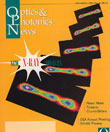
September 1994 Issue
Feature Articles
An Optical Pattern Recognition System For Validation and Security Verification
With the rapid advances in computers, CCD technology, image processing hardware and software, printers, scanners, and copiers, it is becoming increasingly simple to reproduce pictures, logos, symbols, money bills, or patterns. This has stimulated an interest in research, development, and publications1-8 in security technology. In the growing area of biometrics identification, optical techniques are being used in developing products for retinal scanning, hand geometry and vein recognition, and fingerprint identification.
by Bahram Javidi, Joseph L. Horner and John F. WalkupThe Optical Invariant Ii
In the last article on the optical invariant, we showed that an invariant exists between any two paraxial rays traced through an optical system (as long as the rays emanate from different object points). We also showed ways the invariant can be used to quickly establish an optical system concept, and ensure that nothing impossible was being attempted. In this article, we will show how the optical invariant, when combined with an optical system's paraxial raytrace, can conveniently lead to detailed first order analyses. As before, we will use an example to illustrate the methodology involved.
by Pat TrottaA Search For Circular Polarization In Nature
As a child I spent endless hours observing the beautiful butterflies, moths, beetles, and other curious insects that frequently passed through our yard. I am happy to admit that as an adult, I still enjoy observing the plethora of creatures with which we share this planet. In this brief article, I would like to describe some of the hidden surprises our insect friends offer to both adults and children. It is this type of activity that can instill in our young people the appreciation and the importance of all of these creatures to our total ecology.
by George W. KattawarNew Advances Toward A Kilovolt X-Ray Amplifier
In 1895 Wilhelm C. Röntgen published his famous article entitled "Eine Neue Art von Strahlen,"1 which carried the important news of the discovery of X-rays. This advance, which preceded by five years the concept of the quantum of radiation introduced by Max Planck and recognized in 1901 with the first Nobel Prize in physics, led almost immediately to a class of important applications that remains in routine worldwide use today. The first demonstration of X-ray photography of a living body was performed2 on Frau Röntgen's hand in 1895 and Thomas A. Edison sought to make an X-ray image of the brain in the following year. A centenary commemorating Röntgen's discovery will be held in Berlin in June 1995. This history informs us that future advances in X-ray sources can be expected to herald expanded areas of applications.
by Charles K. Rhodes

![A multiplexed image of a human tonsil acquired. [NIAID] using the iterative bleaching extends multiplexity (IBEX) method.](https://opnmedia.blob.core.windows.net/$web/opn/media/images/articles/2024/0424/departments/202404-cover-web.jpg?ext=.jpg)
